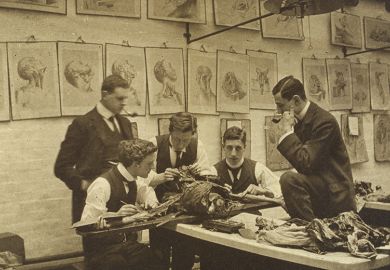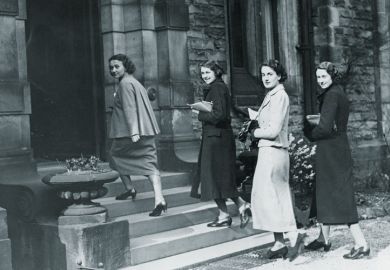The coronavirus pandemic poses a crisis to universities around the world that might seem unprecedented. Yet a new look back over Australian higher education’s last century offers surprising parallels – and potential lessons, too.
Take the 1929 stock market crash, when public spending fell by 20 per cent. By late 1931, all six state governments had slashed grants to the then six universities and, as with today’s Covid crisis, the University of Sydney fared particularly badly. Over the five years to 1934, it forfeited 31 per cent of its annual state funding – losing a princely £24,837 in the currency of the day – and only managed to recover about half of this from other sources.
The universities of Western Australia and Tasmania surrendered 30 per cent of their state grants, with Queensland losing 24 per cent and Melbourne 23 per cent. In those days, state governments were universities’ principal funders.
Adelaide was the only university to escape relatively unscathed because its cut was largely offset by increased funding for its Waite Agricultural Research Institute. Nevertheless, like the other universities, it slashed staff salaries – a modest blow compared to the privation endured elsewhere, as the country’s gross domestic product plummeted 19 per cent.
“Overall, universities did vastly better than most Australians,” a new book says. “Hundreds of thousands of people were unemployed. Farmers’ incomes fell disastrously with the collapse of prices for their produce. Those in tenured positions at universities at least remained in work.”
The book, Australian Universities: A History of Common Cause, was commissioned by Universities Australia to mark the centenary of events that spawned the establishment of its predecessor organisation, the Australian Vice-Chancellors’ Committee (AVCC).
Co-author James Waghorne, a senior research fellow at the University of Melbourne’s Centre for the Study of Higher Education (CSHE), said most university histories focused on particular institutions. “This book [stems] from the moment universities first really connected with one another. By focusing on the whole university system, it shines a light on areas that haven’t really shown up in those individual histories,” he said.
Co-author and CSHE colleague Gwilym Croucher said that by acting collectively, universities had reached accord on issues from job titles and degree structures to hosting rights for disciplines that could not be sustained at every institution.
“There wasn’t always overwhelming agreement,” Dr Croucher said. “At times there was significant tension. But there have been strong examples of the universities discussing how things should be done. We tend to think of these institutions as competing, but…their cooperation has been important for shaping how Australian higher education looks.”
It proved vital in crises such as the Second World War, helping universities support the war effort through an engineering subcommittee that coordinated contributions to munitions manufacturing and improved ventilation systems in tanks, and through tailored courses on things like naval architecture and radio operations. Universities fast-tracked courses in areas with urgent need of graduates.
But collectivism also helped universities withstand a drive to completely subvert their research and teaching to the war effort. They won limited concessions against inflexible conscription arrangements and enrolment quotas and – in a striking parallel with today’s Job-ready Graduates reforms – requirements preventing students who “failed” their studies from re-enrolling.
Collectivism also helped coordinate their response to the Great Depression. While each university negotiated individually with its state government, the AVCC provided a forum for comparing notes about cost-cutting measures.
This helped ensure “parity” so that they avoided cutting salaries too steeply and undermining their viability after the crisis, Dr Waghorne said. “Talking might seem like wasted time, but it was important for these institutions to be able to speak freely – not just through correspondence but across the table.”
Universities preserved their standing by retaining their ageing professors, simultaneously avoiding pension and recruitment costs. Blanket salary cuts included 10 per cent at Adelaide, 10-15 per cent at Melbourne and 13-15 per cent at Queensland.
A former university human resources director, who asked not to be named, said coronavirus-era vice-chancellors should have acted likewise with a universal 10 per cent reduction to work allocations. By applying such a measure to all but the lowest paid staff, universities could have overcome union objections and avoided the worst of the coronavirus impacts. “For the life of me, I can’t see why they didn’t do it as a first step.”
In another episode with a modern-day echo, national security agency Asio monitored Australian academics during the Cold War and deemed 63 University of Melbourne staff to be security risks “based on tenuous and in some cases demonstrably false evidence”, the book says.
In July, two Chinese literature scholars were barred from Australia due to adverse Asio assessments that are yet to be explained. Dr Waghorne said 1950s parallels included Asio’s blocking of academic appointments in Australia and suspicions about the activities of students educated under the Colombo Plan – generally regarded as a triumph of Australian soft power – after their return to their Asian homelands.
Universities played dominant roles in developments from post-war reconstruction to the introduction of the internet, the book shows. In the early days of television, they toyed with buying a joint licence – an idea emulated decades later when they bankrolled The Conversation.
“Universities have been integral to a lot of events,” Dr Croucher said. “But because they’re so ubiquitous, we forget their role.”
Register to continue
Why register?
- Registration is free and only takes a moment
- Once registered, you can read 3 articles a month
- Sign up for our newsletter
Subscribe
Or subscribe for unlimited access to:
- Unlimited access to news, views, insights & reviews
- Digital editions
- Digital access to THE’s university and college rankings analysis
Already registered or a current subscriber?












